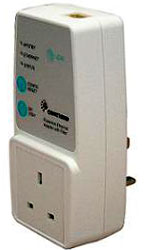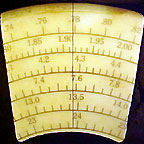Sunday 27 July, 2008, 09:12 - Amateur Radio
Posted by Administrator
The European Telecommunications Standard Institute (ETSI) is currently in the process of finalising a standard for in-home Power Line Telecommunications (PLT). This is equipment that allows internal electrical wiring in a house to be used as a local area network, to carry computer and other data signals around without having to re-wire your house to do so. Whilst wireless networks do much the same, the advantage of PLT is that it could be built into, for example, a television, to allow it to interconnect with a video server or even a set top box, without the need for additional leads and connectors.Posted by Administrator
 These devices (for example those sold by Homeplug) work by sending signals around the mains wiring at frequencies between around 3 and 30 MHz. Now the wiring in a typical house is designed to carry signals at 50 or 60 Hz, depending which country you are in, and although it is possible, with sufficient brute force and ignorance, to get signals in the short-wave (high frequency or HF) frequency range from one socket to another, the network is very (very) leaky. Much of the signal leaves the wiring in the house with the potential to cause interference to any HF user in the vicinity (say, within 100 metres or so).
These devices (for example those sold by Homeplug) work by sending signals around the mains wiring at frequencies between around 3 and 30 MHz. Now the wiring in a typical house is designed to carry signals at 50 or 60 Hz, depending which country you are in, and although it is possible, with sufficient brute force and ignorance, to get signals in the short-wave (high frequency or HF) frequency range from one socket to another, the network is very (very) leaky. Much of the signal leaves the wiring in the house with the potential to cause interference to any HF user in the vicinity (say, within 100 metres or so).Much of the work being done by ETSI is to try and find ways of stopping these PLT devices from causing interference. To start with, the specification requires that there be notches in the transmitted spectrum in all the amateur radio bands to try and reduce interferece to radio amateurs. This is a good start but does not solve the problem for short wave listeners (e.g. those who like to listen to international short wave broadcasts).
 The most recent studies that have been done have been to address specifically this issue and the result is a specification which attempts to monitor the various short-wave bands and if it senses activity in a band, will not use frequencies in that range. So if the device detects a signal on, say, 5.9 MHz, it will not use frequencies in the 49 metre band. There is a little more intelligence than this included, such that if only signals on low frequency ranges can be detected, the device will assume it is night-time (when few high frequencies propagate) and vice versa, and from this information will make further informed decisions about which frequencies might be clear to use.
The most recent studies that have been done have been to address specifically this issue and the result is a specification which attempts to monitor the various short-wave bands and if it senses activity in a band, will not use frequencies in that range. So if the device detects a signal on, say, 5.9 MHz, it will not use frequencies in the 49 metre band. There is a little more intelligence than this included, such that if only signals on low frequency ranges can be detected, the device will assume it is night-time (when few high frequencies propagate) and vice versa, and from this information will make further informed decisions about which frequencies might be clear to use.This is fine, as long as: (a) the detection algorithms work properly and (b) the frequencies allocted to the short-wave broadcast bands remain as is and don't get expanded or moved around. Of course such a system will not protect out-of-band broadcasters or other services which use HF frequencies such as the military, maritime and aeronautical communications. Nonetheless, it at least shows a willingness to take account of domestic short-wave radio usage where the impact of the devices will be greatest.
Step up to the podium, then, BT Vision who have begun using PLT technology to connect their set top boxes into televisions (the two usually being in different rooms in the house) through the electrical wiring. However the devices they are using were developed prior to the completion of the ETSI standards and do not have the sensing mechanisms in place. One device in particular, made by Comtrend (Model DH-10 PFUK to be specific). It provides a 200 Mbps connection between sockets and can be bought independent of BT from various suppliers.
 This device (and some others like it) have started to cause enormous headaches to domestic HF reception, both amateur and broadcast. You will find various videos on YouTube demonstrating the problem and a Yahoo! group (UKQRM) has been set up for users to share experiences with these devices. What is encouraging is that Ofcom is taking the situation seriously. One radio amateur reports that after having reported the problems to Ofcom, action was taken and the offending devices replaced with alternative ones which seemed to cure the problem.
This device (and some others like it) have started to cause enormous headaches to domestic HF reception, both amateur and broadcast. You will find various videos on YouTube demonstrating the problem and a Yahoo! group (UKQRM) has been set up for users to share experiences with these devices. What is encouraging is that Ofcom is taking the situation seriously. One radio amateur reports that after having reported the problems to Ofcom, action was taken and the offending devices replaced with alternative ones which seemed to cure the problem.Driving around the town where I live, I have noted three of these devices, each blocking out reception right the way across the HF frequency bands over a range of around 100 metres. Thankfully none of them are in the immediate vicinity of my own station but the threat exists. If you are suffering this kind of interference, I would urge to you take a look at the UK QRM site or contact Ofcom.
Apparently BT are aware of this problem, with the specific units in question, and will replace them if contacted by their subscriber. This, however, requires anyone who is affected to determine where the interfering signal is coming from and then speak to the person whose house the equipment is installed it. If this is a friendly neighbour, you are fine. If it is not, then your only recourse is through Ofcom. Bon chance!
add comment
( 1768 views )
| permalink
| 



 ( 3.1 / 45136 )
( 3.1 / 45136 )




 ( 3.1 / 45136 )
( 3.1 / 45136 )

